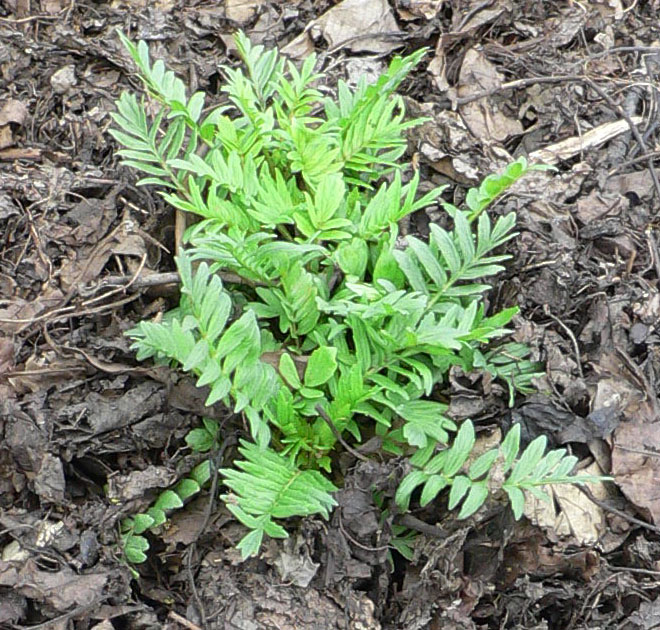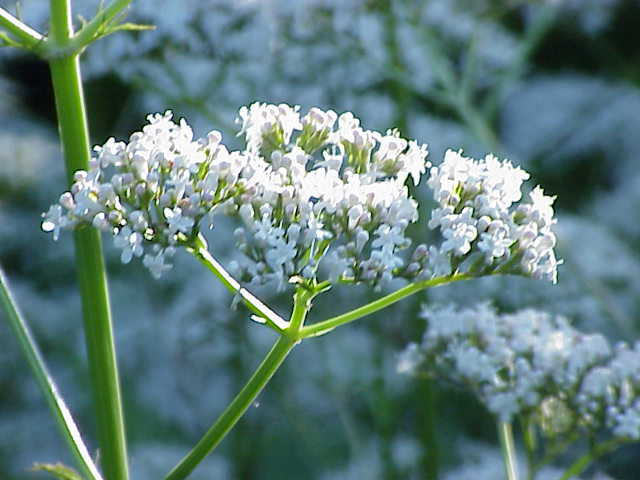Valerian (herb)
| Valerian (plant) | ||||||||||||||
|---|---|---|---|---|---|---|---|---|---|---|---|---|---|---|
 | ||||||||||||||
| Scientific classification | ||||||||||||||
| ||||||||||||||
| Binomial name | ||||||||||||||
| Valeriana officinalis L. & Maillefer |
|
WikiDoc Resources for Valerian (herb) |
|
Articles |
|---|
|
Most recent articles on Valerian (herb) Most cited articles on Valerian (herb) |
|
Media |
|
Powerpoint slides on Valerian (herb) |
|
Evidence Based Medicine |
|
Clinical Trials |
|
Ongoing Trials on Valerian (herb) at Clinical Trials.gov Trial results on Valerian (herb) Clinical Trials on Valerian (herb) at Google
|
|
Guidelines / Policies / Govt |
|
US National Guidelines Clearinghouse on Valerian (herb) NICE Guidance on Valerian (herb)
|
|
Books |
|
News |
|
Commentary |
|
Definitions |
|
Patient Resources / Community |
|
Patient resources on Valerian (herb) Discussion groups on Valerian (herb) Patient Handouts on Valerian (herb) Directions to Hospitals Treating Valerian (herb) Risk calculators and risk factors for Valerian (herb)
|
|
Healthcare Provider Resources |
|
Causes & Risk Factors for Valerian (herb) |
|
Continuing Medical Education (CME) |
|
International |
|
|
|
Business |
|
Experimental / Informatics |
Valerian (Valeriana officinalis, Valerianaceae) is a hardy perennial flowering plant, with heads of sweetly scented pink or white flowers. This "sweet" smell is quite overpowering when the flower is placed into a vase. The flowers are in bloom from June to September. Valerian was used as a perfume in the sixteenth century.
Native to Europe and parts of Asia, Valerian has been introduced into North America. It is consumed as food by the larvae of some Lepidoptera (butterfly and moth) species including Grey Pug.
Other names used for this plant include garden valerian (to distinguish it from other Valeriana species), garden heliotrope (although not related to Heliotropium) and all-heal.
Valerian, in Pharmacology and Phytotherapic Medicine, is the name of a herb or dietary supplement prepared from roots of the plant, which, after maceration, trituration, dehydration processes, are conveniently packaged, usually into capsules, that may be utilized for certain effects including sedation and anxiolytic effect.
The amino acid Valine is named after this plant.
History
Valerian has been used as a medicinal herb since at least the time of ancient Greece and Rome. Hippocrates described its properties, and Galen later prescribed it as a remedy for insomnia.
Etymology
The name Valerian comes from the Latin word valere, meaning "to be strong or healthy", generally thought to refer to its medicinal use, though many references suggest that it also refers to the strong odor.
Biochemical composition
The biochemical active components of valerian extract are:
- Alkaloids: actinidine, catinine, isovaleramide, valerianine and valerine;
- Gamma-aminobutyric acid (GABA), neurotransmitter connected to the sedative plant effects;
- Valeric acid;
- Valepotriates, esters non-glicosidic, firstly acevaltrate, isovaltrate and valtrate;
- Volatile oil containing active sesquiterpenes (acetoxivalerenic acid, valerenic acid);
- Flavanones such as hesperidin, 6-methylapigenin and linarin.
Mechanism of action
Due to valerian's historical use as a sedative, anti-convulsant, migraine treatment and pain reliever, most basic science research has been directed at the interaction of valerian constituents with the GABA neurotransmitter receptor system. These studies remain inconclusive and all require independent replication. The mechanism of action of valerian in general, as a mild sedative in particular, remains unknown. Valerian extracts appear to have some affinity for the GABAA (benzodiazepine) receptor,[1][2] but this activity does not appear to be mediated by valerenic acid, but rather by the relatively high content of γ-aminobutyric acid (GABA) itself.
Preparation

The chief constituent of Valerian is a yellowish-green to brownish-yellow oil which is present in the dried root varying from 0.5 to 2 per cent though an average yield rarely exceeds 0.8 per cent. This variation in quantity is partly explained by location: a dry, stony soil, yielding a root richer in oil than one that is moist and fertile.[3] The volatile oils that form the active ingredient are extremely pungent, somewhat reminiscent of well-matured cheese or wet dog. Valerian tea should not be prepared with boiling water, as this may drive off the lighter oils.
Medicinal use
Valerian is used for insomnia and other disorders.[4][5][6]
In the United States Valerian is sold as a nutritional supplement. Therapeutic use has increased as dietary supplements have gained in popularity, especially after the Dietary Supplement Health and Education Act was passed in 1994. This law allowed the distribution of many agents as over-the-counter supplements, and therefore allowed them to bypass the regulatory requirements of the Food and Drug Administration (FDA).
Valerian is used against sleeping disorders, restlessness and anxiety, and as a muscle relaxant. Valerian seems only to work when taken over longer periods (several weeks), though many users find that it takes effect immediately. Some studies have demonstrated that valerian extracts interact with the GABA and benzodiazepine receptors. Valerian is also used traditionally to treat gastrointestinal pain and spastic colitis. Long term safety studies are missing. As valepotriates may be potential mutagens, valerian should only be used after consultation with a physician.
Valerian medication is sometimes recommended as a first line when benefit-risk analysis dictates. Valerian is often indicated as transition medication during discontinuation processes involving bromazepan, clonazepam and diazepam, among others.
Valerian has uses in herbal medicine as a sedative. The main current use of valerian is as a remedy for insomnia, with a recent meta-analysis providing some evidence of effectiveness.[7] It has been recommended for epilepsy but that is not supported by research (although its analogue valproic acid is used as an anticonvulsant and mood-stabilizing drug). Valerian root generally does not lose effectiveness over time.
While shown to be an effective remedy for the reduction of anxiety, it has also been reported to cause headaches and night terrors in some individuals. This may be due to the fact that some people lack a digestive conversion property necessary to effectively break down Valerian. In these individuals, Valerian can cause agitation.[8] One study found that valerian tends to sedate the agitated person and stimulate the fatigued person, bringing about a balancing effect on the system.[9]
Oral forms, usage and adverse effects
Oral forms
Oral forms are available in both standardized and unstandardized forms. Standardized products may be preferable considering the wide variation of the chemicals in the dried root, as noted above. When standardized it is done so as a percentage of valerenic acid or valeric acid. Physician Formulas makes a 300 mg capsule standardized to 0.8% valerenic acid (2.4mg).[10] Nature's Sunshine Time-Release Valerian tablet contains 500 mg of valerian root extract standardized to 0.8% valerenic acid (4mg).[11] Nature Made makes a 400mg capsule standardized to only 0.28% valerenic acid (0.56mg).[12] Nutraceutical makes two 50mg capsules under the names Solaray and Thompson standardized to 0.8% valeric acid (0.4mg).[13]
Usage
Dosage is difficult to determine due to the lack of standardization and variability in available forms. Typical dosages of the crude herb vary from 1-10 grams per day. Valerian root is non-toxic but may cause side effects in excessive doses.
Adverse effects
Few adverse events attributable to valerian have been reported.[4] Large doses or chronic use may result in stomach ache, apathy, and a feeling of mental dullness or mild depression. In some individuals, valerian can cause stomach ache, anxiety, and night terrors (see above).
Effect on Cats and Rats
An unusual feature of valerian is that the dried root affects the domestic cat in a similar way as that of catnip. If valerian root is left in a place to which cats have access, they will roll in it, salivate onto it and eat it.[3] Burmese cats are attracted to the dried herb and will deliberately destroy containers to obtain it. However, some cats will not go near valerian root.
Valerian's effect on cats is featured as a clue in two works by Agatha Christie.
Valerian is also very attractive to rats, so much so that it has been used to bait traps. Some versions of the legend of the Pied Piper of Hamelin have him using valerian, as well as his pipes, to attract the rats.[3]
Notes
- ↑ Holzl J, Godau P. (1989). "Receptor binding studies with Valeriana officinalis on the benzodiazepine receptor". Planta Medica. 55: 642.
- ↑ Mennini T, Bernasconi P; et al. (1993). "In vitro study in the interaction of extracts and pure compounds from Valerian officinalis roots with GABA, benzodiazepine and barbiturate receptors". Fitoterapia. 64: 291–300.
- ↑ 3.0 3.1 3.2 "Valerian". botanical.com. Retrieved 2007-04-15.
- ↑ 4.0 4.1 "Questions and Answers About Valerian for Insomnia and Other Sleep Disorders". Office of Dietary Supplements • National Institutes of Health. 4/13/2006. Retrieved 2007-04-11. Check date values in:
|date=(help) - ↑
"Valerian". American Family Physician. 4/13/2006. Retrieved 2007-04-12. Check date values in:
|date=(help) - ↑
"Valerian (Valeriana officinalis L.)". Medline Plus. 10/1/2006. Retrieved 2007-04-12. Check date values in:
|date=(help) - ↑ ncbi.nlm.nih.gov
- ↑ herbaleducator.com
- ↑ [1]
- ↑ "Valerian Root Extract 300 mg". Retrieved 2007-04-11. Unknown parameter
|publishe=ignored (help) - ↑ "VALERIAN ROOT EXTRACT TIME RELEASE". naturessunshine.com. Retrieved 2007-04-11.
- ↑ "Valerian Root 400mg". naturemade.com. Retrieved 2007-04-11.
- ↑ "Valerian Root Extract 50mg". nutraceutical.com. Retrieved 2007-04-11.
See also
- Anxiolytic
- Nepeta
- Valine
- Sedative
- Valeric acid
- Valeriana
- Sweet Valerian
- Tisane
- Valerianaceae
- Insomnia
- Red Valerian
- Spikenard
- ATC code N05
- Valeriana
- Köhler's Medicinal Plants
- Anxiety
- Herbalism
- Special Herbs, Vols. 4, 5 & 6
- Special Herbs, Vols. 5 & 6
- Orvietan
External links
cs:Kozlík lékařský de:Echter Baldrian eo:Valeriano it:Valeriana officinalis lv:Ārstnieciskais baldriāns hu:Macskagyökér nl:Echte valeriaan no:Legevendelrot sr:одољен sv:Läkevänderot uk:Валеріана лікарська